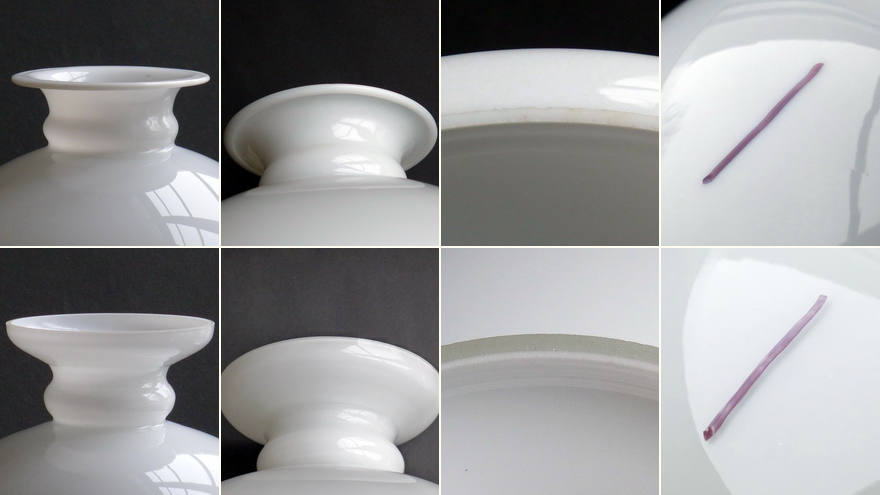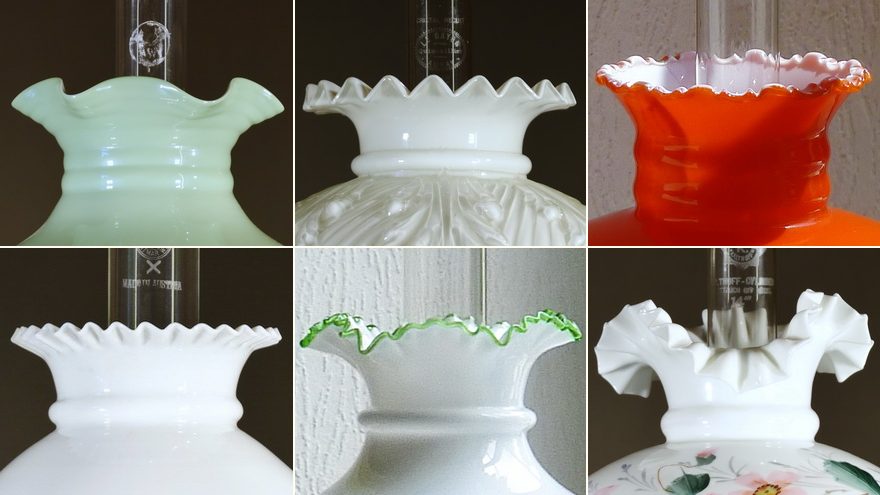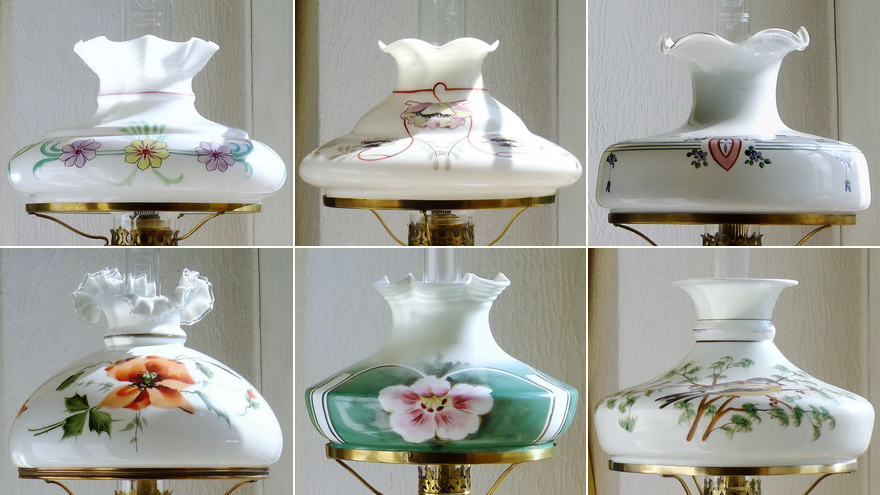Vesta- and Rochester-Shades
The wide shades, mostly made of colourless white opaque milk glass, are in my opinion the typical, very widespread shades for all kinds of table lamps, hanging lamps and reading lamps (= student lamps). Due to their shape, they provide a soft, pleasant, indirect light into the room. They have a very wide opening at the bottom, which can even be as wide as the bulge diameter of the shade itself. This allows unfiltered, direct light to fall downwards, at least near the lamp, which makes working, reading, writing in this area well possible. The shade tapers towards the top, either in a convex curve, i.e. slightly curved outwards like a somewhat flattened dome, or conically without any curvature, like an inverted funnel. The upper opening is usually much smaller than the lower one, but is large enough to let the glass chimney come through comfortably. The upper opening spreads outwards again a little. This slight widening, not unlike an open flower, just above the narrowest point has the purpose of allowing the shade to be easily grasped at this point (at the "neck") with one hand and removed from the lamp.
The shades with the outward curved shape are often referred to as "Vesta” shades. The name comes from the Roman goddess Vesta, who was worshipped as the guardian of sacred fire and the goddess of home and hearth (source: Wikipedia). Wild & Wessel called their famous reading lamp (no. 1373) the Vesta lamp, which had a shade made of milk glass specially designed for this lamp. Presumably, over time, this name was used for all other similar-looking glass shades. Following this tradition, I use this designation for all shades of this type that have a decided fitter at the bottom. Other names for these shades sometimes appear in the old catalogues. One German term often used is "Kuppelschirm" (= Dom shade). Another term, mainly used in Austria, is "Stürzel".
The non-convex, conical shades could also be an invention of Wild & Wessel, because in some catalogues their shape is called "W. & W. shape". To my mind, they even seem to have come onto the market a little earlier than the curved shapes. Many smaller table lamps in the catalogues are fitted with these conical shades. Obviously they don't have a special name. I call them "conical Vesta shade", even if this designation is a bit off the mark.
The Vesta shades curve slightly inwards just below their widest point and then end with an approx. 1 cm high, vertical fitter so that they can be securely inserted into the shade holder. The shade size is indicated by the diameter of this fitter (= fitter width). There are newly produced Vesta shades from 105 mm up to 300 mm fitter width (in Europe). The only suppliers in Germany are www.hytta.de and www.pelam.de (some even made of coloured glass). The conical Vesta shades usually have a fitter width of 190 and 210 mm and are very rare to find today; they are not newly produced. The Vesta shades of American lamps usually have 7 inch (just under 180 mm), or 10 inch (approx. 250 mm) fitter widths. The 10 inch shades from the USA do not fit into the European shade holders.
For the large hanging or floor lamps, larger shades were naturally designed, which are mostly - analogous to the classic Vesta shades - domed. However, these shades do not have a fitter; they are spread dome-like towards the bottom and the lower edge is also the widest part. This is the only difference from the Vesta shades. These Vesta-like shades without extra fitter are called "Rochester” shades. The name probably comes from the American lamp factory Rochester Lamp Co. which was the largest and best-known lamp manufacturer in the USA at the time. The name was then adopted for the corresponding European shades. Rochester shades in Europe have diameters up to 400 mm. www.hytta.de offers newly manufactured Rochester shades from 275 to 330 mm in diameter. The American Rochester shades were also popular in smaller table lamps, so they have either 10 inch (for table lamps) or 14 inch (approx. 355 mm; for hanging lamps) diameters. The upper opening of the Rochester shades is almost always flat without waves.
A variety of Rochester shades are the shades for reading or student lamps. These shades are relatively narrow up to a maximum fitter width of 175 mm, are cylindrical rather than domed in the lower area and are often green to dark green in colour.

Vesta and Rochester shades (size indicated is the fitter size)
Top row, from left: Classic Vesta shade, convex curved, 235 mm
Conical Vesta shade, 210 mm
American Vesta shade of embossed glass, 250 mm
Bottom row, from left: American painted Rochester shade, 250 mm
Pale green Rochester shade for hanging lamps, Veritas, Great Britain, 300 mm
Green shade for reading lamps, 150 mm
The really old shades can be easily distinguished from the much younger shades produced only in the last few decades. The old shades have a "flat folded rim" at the top. This can be described as follows: The opening widens rapidly outwards to end with a horizontal rim area. The outer edge of the rim is then turned briefly downwards and folded flat. The new shades usually have a completely different looking opening, the edge of which widens more or less diagonally upwards. In addition, the top rim is never turned flat downwards.
Another distinguishing feature is the processing of the glass. The glass of an old shade is white throughout, i.e. it consists of one type of glass. The newer shades, on the other hand, consist of two layers of glass; the white milk glass layer has been overlaid with a second layer of transparent, colourless glass. This has saved costs, although the production of these shades requires one more process. The two layers of glass can best be recognised by the plane-ground edges of the upper and lower openings. A stroke with a dark felt-tip pen on the outer wall also creates a clearly recognisable shadow on the milk glass inside.

Distinction between old and newer Vesta shades
Top row: Old Vesta shade with flat folded top rim (milk glass as one layer) and test with the felt-tip pen
Lower row: Newer Vesta shade with plane ground top rim (milk glass, colourless and transparent overlay) and test with the felt-tip pen
There are, however, shades with a top opening that has a fluted edge instead of a flat edge, giving the shade a playful look that is more in keeping with Art Nouveau. Even more playful openings are double waved: The rim has the usual shape of a wide wave, and the edges of the large waves are again ruffled, this time much smaller and very numerous (like the ruffled hem of a lady's skirt). I call this type of wave "fluted and frilled". This shape is sometimes called "skirt shape" in the German literature.

Ornamental forms of the top rim
Top row, from left: Waved with few wide waves – Waved with multiple small waves – With multiple notches
Bottom row, from left: Ruffled only – Fluted and frilled, with green trimmed edge - Skirt shape
In addition to the colourless, opaque white shades, there are also coloured ones, which are usually made by overlaying an opaque white milk glass layer with a coloured transparent glass layer. The inner glass layer must always be opaque-white so that the light of the flame is reflected downwards without attenuation. As far as I know, the old coloured Vesta shades were either light green (e.g. Art Nouveau shades with wavy upper rim) or dark green (mainly for the reading lamps). Vesta shades of other colours are probably an invention of more recent times, probably from around the middle of the last century as Vesta shades for the electric table and hanging lamps in the old kerosene/paraffin lamp style. However, they can also be used with conventional kerosene/paraffin lamps. Nowadays, shades are available in all shades of red, orange, yellow, dark green, light green, turquoise green, light blue, light brown, even violet red and dark blue. The darker the glass colour, the less light the lamp spreads in the rest of the room. The most pleasant shades are the lighter nuanced ones in light cream yellow or light amber yellow. Such shades from more recent production are also available in finely cut, colourless crystal glass or in transparent glass with printed motifs. Of course, it is a matter of taste whether one chooses a coloured Vesta shade from more recent production for an old lamp from around 1900, which does somewhat detract from the authenticity of the lamp. Nevertheless, I have some lamps with such coloured shades from later production in my collection.

Coloured or cut crystal Vesta shades of recent manufacture
The Vesta shades and their variants were the preferred shades for lamps from Germany and Austria. In the Art Nouveau period, around 1900 to 1920, shades were developed with a slightly different shape from the classic Vesta shade described above. For example, the normally convex curvature of the Vesta shade was replaced with a more angular shape, or the normally quite short neck area was stretched out. Very many Vesta shades with an Art Nouveau shape have a wavy top rim, often also in the German “skirt shape”.
The most beautiful version of the Vesta and Rochester shades and their differently shaped variants is certainly the hand-painted shade. Especially in the Art Nouveau period, the white shades were painted imaginatively and in several colours. The dominant motifs were flowers, plants and birds, sometimes supplemented with garlands and other beautiful decorative lines. These shades are much sought after today and correspondingly expensive. The newer versions are not painted but printed. Vesta shades printed with floral motifs (as well as the classic white or coloured shades) can be purchased online. The old, painted shades, on the other hand, have to be bought in antique shops (if they offer any) or bought at auction on eBay. I have sometimes bought a rather banal table lamp only because it had an original old painted Art Nouveau shade...

Hand-painted Vesta shades with Art Nouveau shapes
The second last shade: Schreiber & Neffen, Vienna


